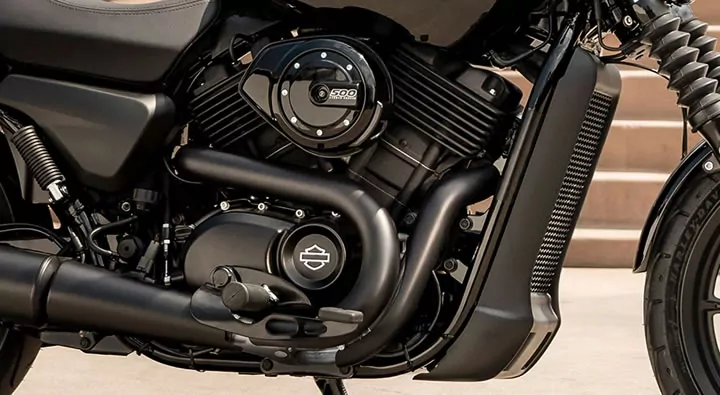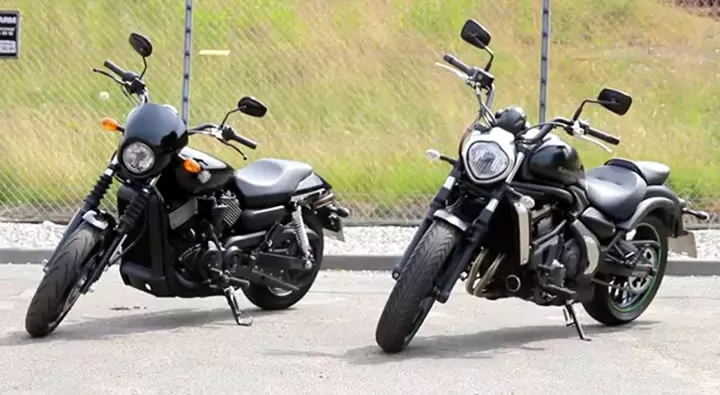A question came to me via e-mail: “Why do some Harley owners hate the Street 500 and Street 750 motorcycles?” Well, hate is a bit of a strong word, but as a Harley owner who dislikes the Street 500 and Street 750, I felt I could give a qualified answer.
SPOILER ALERT: It has nothing to do with liquid cooling or small displacement size.
There are two main reasons (and a few ‘bonus’ reasons) why Harley owners don’t like the Street 500/750. Some of these I agree with, some I don’t. This is a bit of Harley-Davidson Street review, from a passerby’s perspective.


Let the Harley-Davidson Street review begin
1) The motor is not a traditional Harley-Davidson motor
Harley-Davidson’s full name is The Harley-Davidson Motor Company. Think about that. The company is named after their motors, not their motorcycles. Over 100 years after it’s founding, Harley-Davidson still places emphasis on its motors, so much so that other manufacturers have intentionally tried to duplicate their sound. The Street 500 and 750 represent a big shift from that traditional push-rod, air cooled, Harley-Davidson motor. It uses no push rods and opts for liquid cooling instead of air cooling. Harley-Davidson motorcycles also tend to be big displacement, low RPM gas hogs. The Street 500 and 750 motorcycles don’t sound like, look like, feel like, or ride like a traditional Harley-Davidson. That irks some people.

2) The quality is terrible and cheapens the overall Harley brand
When you’re a premium company, it doesn’t matter what your industry is, people expect a premium level of quality or service. When you don’t deliver on that expected quality level, it doesn’t just hurt the reputation of your product or service, it hurts your entire brand.
Any motorcycle manufacturer could build a budget-friendly entry-level motorcycle. It’s one thing to build that bike, it’s another thing to build it well. One company doing it right is Yamaha with their Yamaha R3, the baby-sibling of their famed R6 supersport. The R3 boasts R6-inspired style, outperforms the other motorcycles in it’s class, and it still offers a level of fit and finish for it’s price-point.

Harley-Davidson Street 750 vs the Kawasaki Vulcan (650) – Sure the Vulcan isn’t a traditional cruiser, with it’s parallel twin cylinder engin, but even from this grainy picture the fit, finish, and quality difference is evident.
So how does Harley-Davidson’s Street family of motorcycles do compared to the competition? Piss-poor. Whether we’re talking about performance, quality of parts, reliability, or fit and finish, the Street 500 and 750 motorcycles have serious weaknesses to at least some if not all of their major competitors. Take a look at the welding on the frame of a Street 500 or 750. Also look at the way the wires come in to the hand controls. The bike just yells cheaply built like no other Harley-Davidson ever has, since the AMF years… but Harley owners don’t talk about that either.
In the eyes of Harley owners, buying a Harley-Davidson should mean buying a well made product, and if it doesn’t outright beat it’s competition, it should at least outshine and outlast it. The Street does none of these things. That Yamaha R3 on other hand, it’s a pretty spiffy machine!
Click the little unmute button in the bottom left corner to unmute the video.
Other small issues that make some people dislike the Harley-Davidson Street 500 and 750 motorcycles
- Harley-Davidson announced that the Street would be manufactured overseas for sale in foreign markets (India). This meant that the bike would not be made by American workers, who would then ship the bike overseas, but rather would cost Americans their jobs in the eyes of some. Read this story on Harley-Davidson closing down their factory in Kansas City for more on that.
- Even Harley-Davidson’s own dealers don’t want to push the vehicle or speak highly of it. They know doing so would damage their own credibility. Dealerships and sales people (who rely on their reputation to put bread on the table) just don’t want to be associated with this machine. That hurts it’s reputation.
- The brakes are weak by modern street bike standards, but, I guess that’s okay, because the performance is even worse.
- The fact Harley-Davidson couldn’t be bothered to put practical usable mirrors on this show the Motor Company’s own cost-cutting disinterest with this bike. It was never built as a point-of-pride for the brand. Rather it was made as a necessity dictated by consulting firms and the accounting department.
- Common issues and recall issues (look up Harley Street lag and leap on Google for examples…)
Conclusions
I worked for Harley-Davidson Canada when the Street came out and remember feeling it was lackluster at the time. I’ve also worked as a salesperson on a (non-Harley) dealership showroom floor. Trying to sell a bike you don’t believe in is no zero fun, trust me.
Don’t buy into anyone telling you that the Street is only unloved because it’s liquid cooled, small, inexpensive, and/or dainty. The reality is that Harley-Davidson failed to make a budget-friendly entry-level motorcycle that Harley enthusiasts, sales people, and dealers, could happily embrace and recommend.
 YouMotorcycle Motorcycle Blog – Motorcycle Lifestyle Blog, MotoVlog, Motorcycle Reviews, News, & How-Tos
YouMotorcycle Motorcycle Blog – Motorcycle Lifestyle Blog, MotoVlog, Motorcycle Reviews, News, & How-Tos
Hello thought I would share this with after reading your blog.
After my first Harley experince being a brand new 2019 Sport glide I would suggest that they are not to worried about there brand name and providing a high quility finish on the bigger bikes either. The dummy fuel cap, that fell off while cleaning, is attached with double sided sticky tape, yes the stuff my 4 year old son uses to make rockets out of tiolet roll holders with. Also the tank trim between the seat and console came loose and was repaired by the dealer with super glue. Doesn’t scream quality brand that deserves it’s top end price tag to me.
Woah! That’s definitely disappointing considering the ticket price on one of those things brand new. Unbelievable.
Check the facts. The Streets sold here in the US are MADE here right in the good ol’ US of A!
Hi Chris. Yes, you said the exact same thing that I said.
“Harley-Davidson announced that the Street would be manufactured overseas for sale in foreign markets (India). This meant that the bike would not be made by American workers, who would then ship the bike overseas, but rather would cost Americans their jobs in the eyes of some.”
In the past, Harley-Davidson’s made for foreign markets were made in America, by American workers, meaning more jobs in America.
With the Street being produced outside of the US for foreign markets, there are less bikes for Americans to build, therefor less work for Americans.
Like you said, the domestic bikes are made in the US, but the foreign ones are not, and that was a new thing for Harley.
Harley’s only fault is pushing anything that’s not a big twin to the back of the store. The V-Rod was the best bike Harley ever made and it faded because of lack of sales effort. None of the magazines have called the Street models cheap or unreliable. I see you own a Harley, probably a big twin, so you can’t say you’re not without prejudice. I would love to hear your opinion on the Livewire.
Hey Jim. I do own a Harley, the one you called “the best bike Harley ever made” – the V-Rod. The magazines haven’t called the Street cheap or unreliable because the magazines get $20,000 every time Harley takes out a full page advertisement with them. If you want to talk about prejudice, just think about that for a minute. Who are you going to trust, the guy with no skin in the game, or the one who’s bills and employees are paid by HD? Food for thought…
As for the LiveWire, I have more hands on experience with them then many others. When I worked for Harley-Davidson I was on their special events team here in Canada. I traveled with a LiveWire to Edmonton, Calgary, Montreal, and was happy to show it to my friends when we had it here in Toronto. I have a few cool LiveWire stories to share but that’s probably a story on it’s own. Hoping it’ll do well. I haven’t seen the production LiveWires yet, but the LiveWires that I demo’d to the media had top notch finishes.
Here’s my point on all this. I’ve owned a few of the worst fit and finish Japanese companies. Kawasaki. BUT. As far as I’m concerned it’s the engine that gets you down the road. AMF Harley’s glowed. The engines sucked. Beta Twin cam Harley’s glowed, the engines chewed cam chains and sucked. The jury is out on the Milwaukee Eight and I’ll jump all over them if they start spewing engine bits.
I’m betting that these terrible fit and finish Street models will have engines, like the V-Rod, that outlast all the potato, potato models. If they don’t glow, stop like a Ninja or impress the HOG faithful, who cares. I’m betting they will start every morning, always get you where you’re going and run till you’re bored with it and decide to get something S&S makes engines for. I always bought Kaasaki because the engines were built to stand up to donut spinning wheelie specialists. It’s the engine that gets you down the road as you’ve seen with your bike.
I just visited Santa Fe Harley Davidson in New Mexico in August, 2019 to replace a wheel damaged by my first road hazard hit in 200,000 miles. I saw two used Street 750’s and asked the salesman how they were selling. His response was that they can’t keep them in the showroom, new or used. Somebody must like them, at least in New Mexico.
I liked my 2012 Road Glide with its Twin Cam 103 engine and just had that engine rebuilt at 95,000 miles. This bike replaced a 2004 Road King with a Twin Cam 88 that went 91,000 miles for me. I am told the Milwaukee 8’s run cooler than the Twin Cams, but mine have gotten me down the road pretty well.
Seeing that kind of mileage indicates to me that you take excellent care of your bikes. I would imagine that you have kept an eye on the cam chain adjuster shoes. Others haven’t been as fortunate. A good owner can keep even the cheapest bike on the road. The standard joke is “85% of all Harleys built since 2000 are still on the road. The other 15% made it back to the shop”
I tested a a Street 750 a while back (in the UK). I thought the engine was pretty sound, but the fit and finish was cheap and nasty, and the handling was very poor. I then tried a Sportster and the indicators failed after about a mile, and this was a brand-new bike! I love the idea of a Harley, but for me the build quality just isn’t there. The Japanese caught up years ago, and the Chinese are getting there!
Surprised about the Sportster signals failing. Even with cheap electronic components (or maybe it was just a worn out switch?), the fit and finish on a Sportster is still miles ahead of a Street.